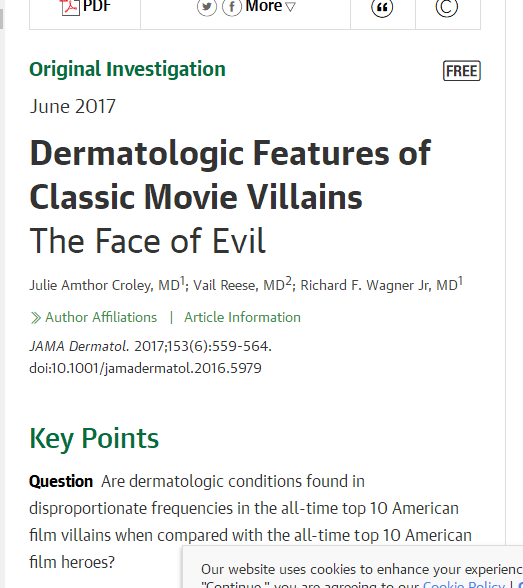The other answers under this question explain how the question came about, which is the story of what the Grey Wolf’s scar is. But there is no explanation as to why the villains have scars on their faces.
The character design of Grey Wolf is not entirely from cats and mice, and its story result is more like “The Smurfs”, which is a kind of asymmetrical confrontation game setting. But in “The Smurfs”, as the villain, Gargamel has the advantage of being oversized, while Big Wolf has the advantage of technology. Although he always fails to capture, he is still portraying a typed villain.
In fact, in many classic film and television works, villains have scars, such as Frankenstein, Voldemort, Mr. Hyde, and of course the Scar in the animated classic “The Lion King”.
In the paper “Dermatologic Features of Classic Movie VillainsThe Face of Evil” Dermatologic Features of Classic Movie Villains: The Face of Evil has summarized the facial features of 10 positive and negative characters in the classic American film industry, and concluded that, At least six of the villains have obvious problems with their faces.

Question Are dermatologic conditions found in disproportionate frequencies in the all-time top 10 American film villains when compared with the all-time top 10 American film heroes?
Findings In this cross-sectional study, the top 10 villains display a significantly higher incidence of dermatologic findings than the top 10 heroes (60% vs 0%), which include alopecia, periorbital hyperpigmentation, deep rhytides on the face, scars on the face , verruca vulgaris on the face, and rhinophyma.
Meaning Dermatologic conditions are used in film to elucidate the dichotomy of good and evil through visual representation, which may contribute to a tendency toward prejudice in our culture and facilitate misunderstanding of particular disease entities among the general public.
In 2018, British academics conducted research on the 30 highest-grossing 12A-rated movies, and the data remained largely unchanged:
The researchers found that 76.5 percent of the bad guys had skin problems, including scars, alopecia areata, and severe wrinkles, compared with 25.9 percent of the good guys. ——Faced with discrimination allegations, Hollywood is still using scars to distinguish between good and bad people – yqqlm
The so-called 12A is a work suitable for the whole family to watch, which also means that the ideological cognition of scar = bad guy is in line with the established cognition of the film and television industry, and it will also affect the audience’s acceptance of its images.
Scar = bad guy is a deeply rooted religious sign, which means the unity of body and mind, that is, a healthy body is equal to a healthy mind, and vice versa, so in religious stories, most of the bad guys’ facial structures are in a state of mutilation. This is also in line with Punotin’s perception of the relationship between evil and good: the good is the perfect knowledge, and the evil is the absence of the good.
From Susan Sontag’s “Metaphors of Disease” to Foucault Michel’s “Madness and Civilization”, all are reflecting on this mind- body unity that has become a mindset. In their reflections, they found the duality of the “evil-disease” relationship, that is, the giver of evil is also the victim of evil, with strong destructive power and weakness that is different from ordinary people. Although the body of a sick person is weak, it is also attached to evil. Furthermore, the weakening of resistance allows a stronger evil to control it. At the same time, it becomes the transmission path of disease (evil) and makes the body sick. A far cry from the “normal civilized man”.
Of course, this logic chain can be further extended. Susan Sontag said that disease is also imagined as a disease of poverty and deprivation, and death is glorified as excessive enthusiasm, that is, “madness” – this is also the reason why in many works, the villain can’t give a reason to be a villain. one. Because the villain is inherently mad and evil, not rational, a villain with a reason will not become a villain.
And the scar on the face in the original version of Grey Wolf could have been explained without explanation. Because before the Guardians of Sheep Village series, he was a pure, unquestionable villain. At that time, the production team’s explanation itself was to abandon the narrative that could be transformed into goodness.
To put it simply, the scars on the face of the gray wolf were scratched by his own father, Wu Dalang, after returning to the past for the second time to avoid the future of the sheep from extinction.
In this interpretive story, we will find three important metaphorical nodes:
①Although the gray wolf has the function of saving the flock objectively, it is also the one that destroys the flock. Nor does it show goodwill for saving the flock.
②Grey Wolf’s scar transcends the setting of time retrospection and becomes a villain symbol that transcends time and space.
③ The scar on the face of the wolf is the injury from his father, which means the conflict between the animal’s natural attributes (racial conflict) and social attributes (parent-child conflict).
In the new version of the story, although Big Wolf still has a scar, but in the process of drawing, a certain degree of cuteness has been processed, and its negative metaphors have been dissolved to become the unique mark of Big Big Wolf.
Let’s take “Future Out of the Basket” as an example. Whether it’s a cute picture or a fierce picture, we try our best to show the fusion of Big Wolf’s scar and face shape instead of violating the harmony.

Source: Zhihu www.zhihu.com
Author: I wish you
[Zhihu Daily] The choice of tens of millions of users, to be a big cow of new things in the circle of friends.
click to download
This question has 2 more answers, see all.
Further reading:
In “Pleasant Goat and Big Big Wolf”, does Mei Yang Yang like Pleasant Goat?
How old are you? Do you know Pleasant Goat and Big Big Wolf?
This article is reproduced from: http://www.zhihu.com/question/311763237/answer/2447501697?utm_campaign=rss&utm_medium=rss&utm_source=rss&utm_content=title
This site is for inclusion only, and the copyright belongs to the original author.